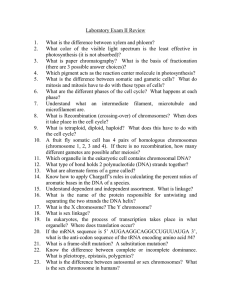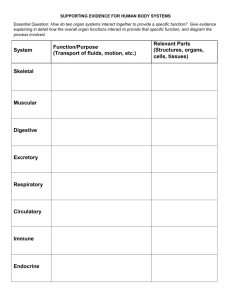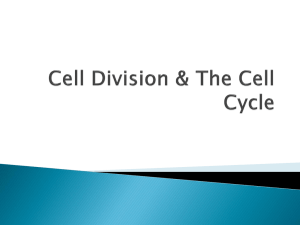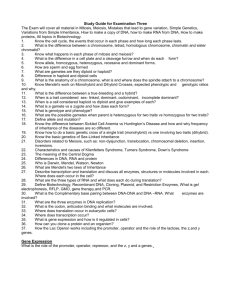Final Study Guide
advertisement
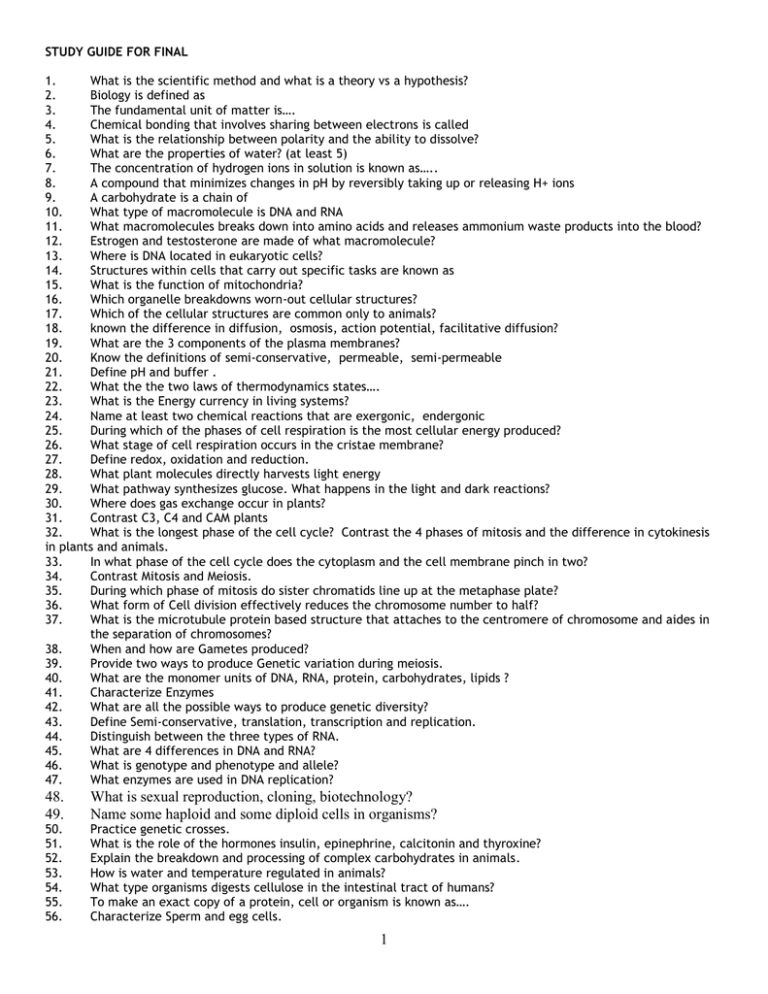
STUDY GUIDE FOR FINAL 1. What is the scientific method and what is a theory vs a hypothesis? 2. Biology is defined as 3. The fundamental unit of matter is…. 4. Chemical bonding that involves sharing between electrons is called 5. What is the relationship between polarity and the ability to dissolve? 6. What are the properties of water? (at least 5) 7. The concentration of hydrogen ions in solution is known as….. 8. A compound that minimizes changes in pH by reversibly taking up or releasing H+ ions 9. A carbohydrate is a chain of 10. What type of macromolecule is DNA and RNA 11. What macromolecules breaks down into amino acids and releases ammonium waste products into the blood? 12. Estrogen and testosterone are made of what macromolecule? 13. Where is DNA located in eukaryotic cells? 14. Structures within cells that carry out specific tasks are known as 15. What is the function of mitochondria? 16. Which organelle breakdowns worn-out cellular structures? 17. Which of the cellular structures are common only to animals? 18. known the difference in diffusion, osmosis, action potential, facilitative diffusion? 19. What are the 3 components of the plasma membranes? 20. Know the definitions of semi-conservative, permeable, semi-permeable 21. Define pH and buffer . 22. What the the two laws of thermodynamics states…. 23. What is the Energy currency in living systems? 24. Name at least two chemical reactions that are exergonic, endergonic 25. During which of the phases of cell respiration is the most cellular energy produced? 26. What stage of cell respiration occurs in the cristae membrane? 27. Define redox, oxidation and reduction. 28. What plant molecules directly harvests light energy 29. What pathway synthesizes glucose. What happens in the light and dark reactions? 30. Where does gas exchange occur in plants? 31. Contrast C3, C4 and CAM plants 32. What is the longest phase of the cell cycle? Contrast the 4 phases of mitosis and the difference in cytokinesis in plants and animals. 33. In what phase of the cell cycle does the cytoplasm and the cell membrane pinch in two? 34. Contrast Mitosis and Meiosis. 35. During which phase of mitosis do sister chromatids line up at the metaphase plate? 36. What form of Cell division effectively reduces the chromosome number to half? 37. What is the microtubule protein based structure that attaches to the centromere of chromosome and aides in the separation of chromosomes? 38. When and how are Gametes produced? 39. Provide two ways to produce Genetic variation during meiosis. 40. What are the monomer units of DNA, RNA, protein, carbohydrates, lipids ? 41. Characterize Enzymes 42. What are all the possible ways to produce genetic diversity? 43. Define Semi-conservative, translation, transcription and replication. 44. Distinguish between the three types of RNA. 45. What are 4 differences in DNA and RNA? 46. What is genotype and phenotype and allele? 47. What enzymes are used in DNA replication? 48. 49. 50. 51. 52. 53. 54. 55. 56. What is sexual reproduction, cloning, biotechnology? Name some haploid and some diploid cells in organisms? Practice genetic crosses. What is the role of the hormones insulin, epinephrine, calcitonin and thyroxine? Explain the breakdown and processing of complex carbohydrates in animals. How is water and temperature regulated in animals? What type organisms digests cellulose in the intestinal tract of humans? To make an exact copy of a protein, cell or organism is known as…. Characterize Sperm and egg cells. 1 57. 58. 59. 60. 61. 62. 63. 64. 65. 66. 67. 68. 69. 70. 71. 72. 73. 75. 76. 77. 78. 79. 80. 81. 82. 83. 84. 85. 86. 89. 90. 91. 92. 93. 94. 95. 96. 97. 98. 100. What is the function of the enzymes amylase, lipase, cellulose, and -galactosidase What is the difference in organ, tissue, community and organisms? What is homozygous, heterozygous, recessive and dominant Know something about sickle-cell anemia, hemophilia and albino pigmentation What are the components of blood? What types of connective tissues are there? What are the four tissues? What are the functions of the 11 organ systems? How is the zygote formed? What are the equations for photosynthesis and cell respiration Why do humans get Vaccinations? Define Antigen, antibody and hormone? Define metabolism What is the role of Luetinizing hormone, progesterone, estrogen, ADH and FSH Review hormones releases from endocrine glands What are the functions of bone? How do muscles work? What are interneurons What is the role of a phagocyte in the immune response? What is CNS, PNS, sympathetic, parasympathetic, autonomic and somatic? What happens to individuals with hyperthyroidism and hypothyrodism? How does HIV attack the immune system? What does the pancreas secrete? What is the difference in an artery and a vein? Draw the parts of each organ system. What happens in each organelle, can you identify each organelle in a picture? Draw a Neuron and know its function. Name parts of neuron in each figure? Be able to recognize a cell in specific phases of mitosis? How does a chromosome differ from a tetrad sister chromatid and homologous chromosome? Which organ system is depicted in Figure 5? What is the organ system in Fig 1, 2, 3, 4, a. Digestive,. Respiratory, Lymphatic (immune), Urinary (Excretory), Reproductive, Integumentary, Cardiovascular, Nervous, Skeletal, Muscular, Endocrine. What is the function of each organ system ? a. Digestive,. Respiratory, Lymphatic (immune), Urinary (Excretory), Reproductive, Integumentary, Cardiovascular, Nervous, Skeletal, Muscular, Endocrine. Concerning Figure 4 What is the trachea, pharynx, bronchus, bronchioles, alveoli, main site of gas exchange Endocrine System. Which is the pituitary, hypothalamus, thyroid, pancreas, thymus, adrenal and male and female gonad? Which gland produces, ACH, TSH, HGH. Calcitonin, Parathyroxine, Epinephrine, FSH, LH, Estrogen, Testosteron, Progesterone, Insulin, Glucagon, Enzymes for the Small Intestin, makes T-cells, thyroxin, In Figure 5 what structure is the rER, sER, Golgi apparatus, Nucleus, nucleolus, cytoplasm, chloroplast, lysosome, vacuole, cell wall , cell membrane, cytoskeleton, centriole, Concerning Fig 6, Which image is in interphase, prophase, metaphase, telophase, cytokinesis. What are two distinctive feature of each phase In Figure 5, the conduit that connects Structure 11 with structure 13 is know as…. Figure 2 is a picture of Where is the atria, ventricles, 2 A/V valve, Pulmonary artery and vein, Aorta and venacava Concerning digestive system: what enzymes are make or used in mouth, stomach and small intestine and what is the function of each. What are all organs shown in the digestive system and what is their function What effect do human activity have of the environment? 2



